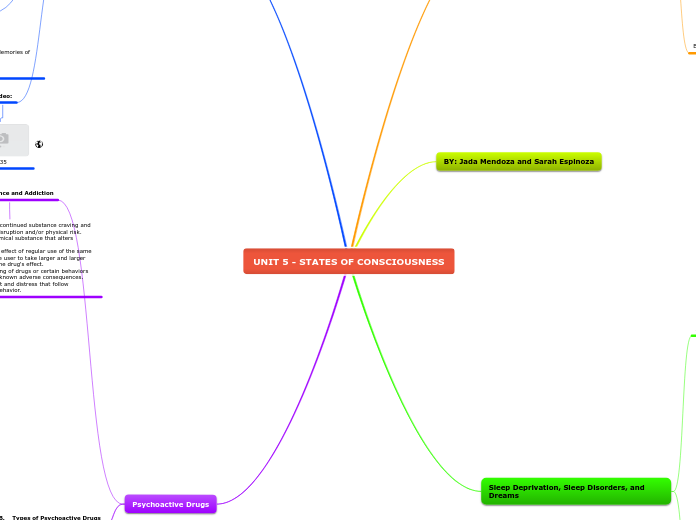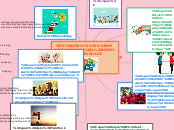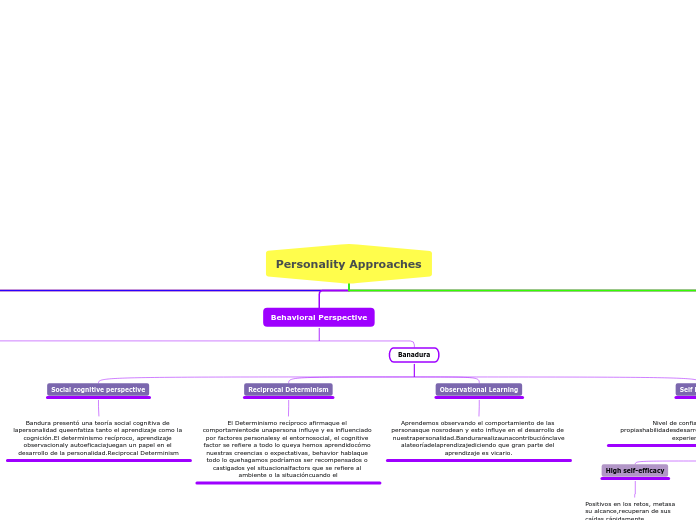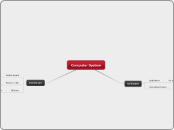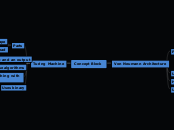UNIT 5 - STATES OF CONSCIOUSNESS
Psychoactive Drugs
10:41
B. Types of Psychoactive Drugs
3. Hallucinogens
Hallucinogens: psychedelic ("mind-manifesting") drugs, such as LSD, that distort perceptions and evoke sensory images in the absence of sensory input.
LSD: a powerful hallucinogenic drug; aka acid (lysergic acid diethylamide).
Near-Death Experience: an altered state of consciousness reported after a close brush with death (such as cardiac arrest); often similar to drug-induced hallucinations.
THC: the major active ingredient in marijuana; triggers a variety of effects' including mild hallucinations.
2. Stimulants
Stimulants: drugs (such as caffeine, nicotine, and the more powerful amphetamines, cocaine, Ecstasy, and methamphetamine) that excite neural activity and speed up body functions.
Amphetamines: drugs that stimulate neural activity, causing speeded-up body functions and associated energy and mood changes.
Nicotine: a stimulating and highly addictive psychoactive drug in tobacco.
Cocaine: a powerful and addictive stimulate, derived from the coca plant, producing temporarily increased alertness and euphoria.
Methamphetamine: a powerful addictive drug that stimulates the central nervous system, with speeded-up body functions and associated energy and mood changes; over time, appears to reduce baseline dopamine levels.
Ecstasy (MDMA): a synthetic stimulant and mild hallucinogen. Produces euphoria and social intimacy, but with short-term health risks and longer-term harm to serotonin-producing neurons and to mood and cognition.
1. Depressants
Depressants: drugs (such as alcohol, barbiturates, and opiates) that reduce neural activity and slow body function.
Alcohol Use Disorder: (popular know as alcoholism). Alcohol use marked by tolerance, withdrawal, and a drive to continue problematic use.
Barbiturates: drugs that depress central nervous system activity, reducing anxiety but impairing memory and judgement.
Opiates: opium and its derivatives, such as morphine and heroin; they depress neural activity, temporarily lessening pain and anxiety.
A. Tolerance and Addiction
Substance Use Disorder: continued substance craving and use despite significant life disruption and/or physical risk.
Psychoactive Drug: a chemical substance that alters perceptions and moods.
Tolerance: the diminishing effect of regular use of the same dose of a drug, requiring the user to take larger and larger doses before experiencing the drug's effect.
Addiction:compulsive craving of drugs or certain behaviors (such as gambling) despite known adverse consequences.
Withdrawal: the discomfort and distress that follow discontinuing an addictive behavior.
Sleep Patterns and Sleep Theories
Video:
4:35
B. Sleep Theories
1. Sleep Protects
2. Sleep Helps Us Recuperate
3. Sleep Helps Restore and Rebuild Our Fading Memories of the Day's Experience
4. Sleep Feeds Creative Thinking
5. Sleep Supports Growth
A. Biological Rhythms and Sleep
3. What Affects Our Sleep Patterns?
Suprachiasmatic Nucleus (SCN): a pair of cell clusters in the hypothalamus that controls circadian rhythm. In response to light, the SCN causes the pineal gland to adjust melatonin production, thus modifying our feeling of sleepiness.
2. Sleep Stages
REM Sleep: rapid eye movement sleep; a recurring sleep stage during which vivid dreams commonly occur. AKA paradoxical sleep, because the muscles are relaxed (except for minor twitches) but other body systems are active.
Alpha Waves: the relatively slow brain waves of a relaxed, awake state.
Sleep: periodic, natural loss of consciousness-as distinct from unconsciousness resulting from a coma, general anesthesia, or hibernation.
Hallucinations: false sensory experiences, such as seeing something in the absence of an external visual stimulus.
Delta Waves: the large, slow brain waves associated with deep sleep.
NREM Sleep: non-rapid eye movement sleep; encompasses all sleep stages excerpt for REM sleep.
1. Circadian Rhythm
Circadian Rhythm: the biological clock; regular bodily rhythms (for example, of temperature and wakefulness) that occur on a 24-hour cycle.
Sleep Deprivation, Sleep Disorders, and Dreams
B. Dreams
2. Why We Dream
-To develop and preserve neural pathways
-To make sense of neural static.
-To reflect cognitive development
-
information-processing perspective proposes that dreams may help sift, sort, and fix the day’s experiences in our memory.
sigmund freud on why we dream: proposed that dreams provide a psychic safety valve that discharges otherwise unacceptable feelings
manifest content according to Freud, the remembered story line of a dream (as distinct from its latent, or hidden, content). latent content according to Freud, the underlying meaning of a dream (as distinct from its manifest content).
REM rebound the tendency for REM sleep to increase following REM sleep deprivation (created by repeated awakenings during REM sleep).
1. What We Dream
our mind also monitors our environment therefore we can dream of a certain smell because we can smell it in real life in our environment.
story line of our dreams incorporates traces of previous days’ nonsexual experiences and preoccupations
dream a sequence of images, emotions, and thoughts passing through a sleeping person’s mind. Dreams are notable for their hallucinatory imagery, discontinuities, and incongruities, and for the dreamer’s delusional acceptance of the content and later difficulties remembering it.
manifest content according to Freud, the remembered story line of a dream (as distinct from its latent, or hidden, content). latent content according to Freud, the underlying meaning of a dream (as distinct from its manifest content).
A. Sleep Deprivation and Sleep Disorders
2. Major Sleep Disorders
insomnia- recurring problems in falling or staying asleep.
narcolepsy- a sleep disorder characterized by uncontrollable sleep attacks. The sufferer may lapse directly into REM sleep, often at inopportune times.
sleep apnea a sleep disorder characterized by temporary cessations of breathing during sleep and repeated momentary awakenings.
night terrors a sleep disorder characterized by high arousal and an appearance of being terrified; unlike nightmares, night terrors occur during NREM-3 sleep, within two or three hours of falling asleep, and are seldom remembered.
Sleep walking and sleep talking run in families
Subtopic
1. Effects of Sleep Loss
sleep strengthens memory, increases concentration, boosts mood, moderates hunger and obesity, fortifies the disease-fighting immune system, and lessens the risk of fatal accidents
“Sleep deprivation has consequences—difficulty studying, diminished productivity, tendency to make mistakes, irritability, fatigue"
predictor of depression
without sleep you are not able to concentrate at the task at hand and you will feel much less motivated and be less precise in your work. Your level of satisfaction (as in your mood) can also corelate to how well you are sleeping.
after not having enough sleep for countless nights, your brain begins to carry a "debt" of amt of sleep lost. You can not repay this debt back with one night of long long sleep
BY: Jada Mendoza and Sarah Espinoza
Understanding Consciousness and Hypnosis
B. Hypnosis
a social interaction in which one person (the subject) responds to another person’s (the hypnotist’s) suggestions that certain perceptions, feelings, thoughts, or behaviors will spontaneously occur.
1. Explaining the Hypnotized State
Our attentional spotlight and interpretations powerfully influence our ordinary perceptions.
-hypnosis involves not only social influence but also a special dual-processing state of dissociation
-selective attention can play role as well in hypnotic pain relief
- To some extent, we are all open to suggestion
-being under hypnosis does not make you act out against your will
-can be therapeutic
-
A. Defining Consciousness
some things that go into our consciousness are usually automatic and they are things that we don't pay much attention to.
some things that DO take conscious effort, with effort it can become like second nature- William James called this a continuous “stream of consciousness,”
conscious awareness is one part of the dual processing
Part of the dual processing in the brain
the Awareness of ourselves and out environment.
https://www.youtube.com/watch?v=1ODcacUzRNo
